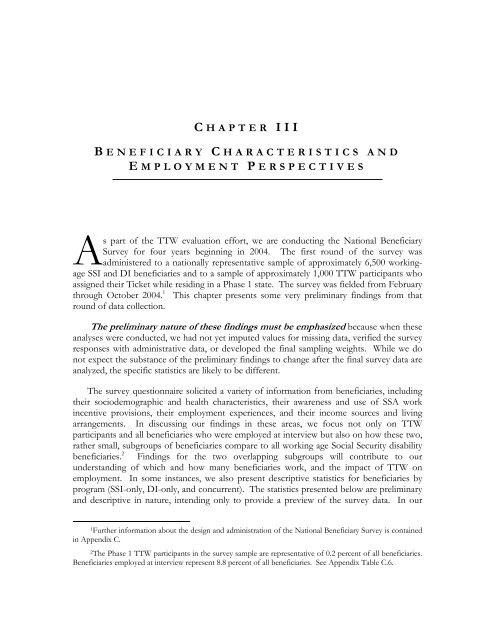Evaluation of the Ticket to Work Program, Implementation ...
Evaluation of the Ticket to Work Program, Implementation ...
Evaluation of the Ticket to Work Program, Implementation ...
You also want an ePaper? Increase the reach of your titles
YUMPU automatically turns print PDFs into web optimized ePapers that Google loves.
C HAPTER IIIB ENEFICIARY C HARACTERISTICS ANDE MPLOYMENT P ERSPECTIVESAs part <strong>of</strong> <strong>the</strong> TTW evaluation effort, we are conducting <strong>the</strong> National BeneficiarySurvey for four years beginning in 2004. The first round <strong>of</strong> <strong>the</strong> survey wasadministered <strong>to</strong> a nationally representative sample <strong>of</strong> approximately 6,500 workingageSSI and DI beneficiaries and <strong>to</strong> a sample <strong>of</strong> approximately 1,000 TTW participants whoassigned <strong>the</strong>ir <strong>Ticket</strong> while residing in a Phase 1 state. The survey was fielded from Februarythrough Oc<strong>to</strong>ber 2004. 1 This chapter presents some very preliminary findings from thatround <strong>of</strong> data collection.The preliminary nature <strong>of</strong> <strong>the</strong>se findings must be emphasized because when <strong>the</strong>seanalyses were conducted, we had not yet imputed values for missing data, verified <strong>the</strong> surveyresponses with administrative data, or developed <strong>the</strong> final sampling weights. While we donot expect <strong>the</strong> substance <strong>of</strong> <strong>the</strong> preliminary findings <strong>to</strong> change after <strong>the</strong> final survey data areanalyzed, <strong>the</strong> specific statistics are likely <strong>to</strong> be different.The survey questionnaire solicited a variety <strong>of</strong> information from beneficiaries, including<strong>the</strong>ir sociodemographic and health characteristics, <strong>the</strong>ir awareness and use <strong>of</strong> SSA workincentive provisions, <strong>the</strong>ir employment experiences, and <strong>the</strong>ir income sources and livingarrangements. In discussing our findings in <strong>the</strong>se areas, we focus not only on TTWparticipants and all beneficiaries who were employed at interview but also on how <strong>the</strong>se two,ra<strong>the</strong>r small, subgroups <strong>of</strong> beneficiaries compare <strong>to</strong> all working age Social Security disabilitybeneficiaries. 2 Findings for <strong>the</strong> two overlapping subgroups will contribute <strong>to</strong> ourunderstanding <strong>of</strong> which and how many beneficiaries work, and <strong>the</strong> impact <strong>of</strong> TTW onemployment. In some instances, we also present descriptive statistics for beneficiaries byprogram (SSI-only, DI-only, and concurrent). The statistics presented below are preliminaryand descriptive in nature, intending only <strong>to</strong> provide a preview <strong>of</strong> <strong>the</strong> survey data. In our1 Fur<strong>the</strong>r information about <strong>the</strong> design and administration <strong>of</strong> <strong>the</strong> National Beneficiary Survey is containedin Appendix C.2 The Phase 1 TTW participants in <strong>the</strong> survey sample are representative <strong>of</strong> 0.2 percent <strong>of</strong> all beneficiaries.Beneficiaries employed at interview represent 8.8 percent <strong>of</strong> all beneficiaries. See Appendix Table C.6.
















